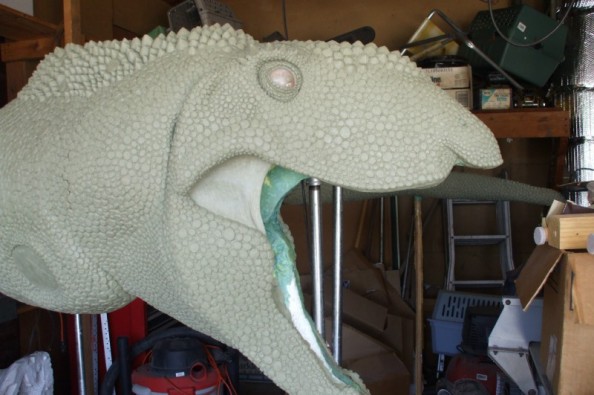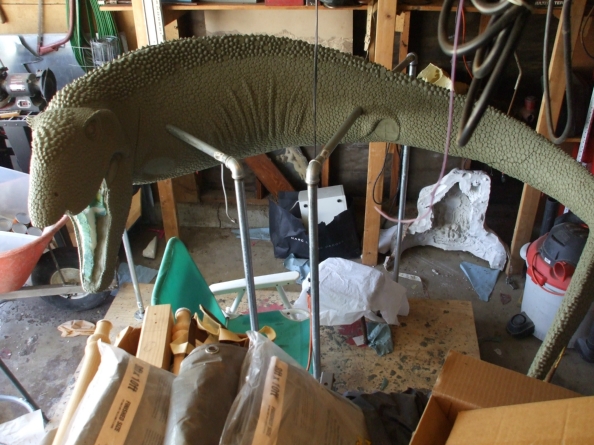Dimetrodon Days Are Here Again
Posted by: Craig Woolheater on May 29th, 2013

From my good buddy, Lee Murphy, author of Where Legends Roam, Naitaka, Heretofore: Unknown and Ygor:
This is an 11-foot (lifesize) model of the Permian predator Dimetrodon I am building to start a business building museum displays. I need funding to complete the model which is partially molded and will be finished in fiberglass when complete. Thank you for your consideration!Lee Murphy
Help Lee make this a reality by making a contribution to this project here!
Not only is Lee working on this project, he is currently writing the fourth in the line of Kodiak books, this one featuring the Loch Ness Monster.

Dimetrodon was the Tyrannosaurus rex of the Permian epoch. A popular animal among paleo enthusiasts such as myself, it is often mistaken for a dinosaur, even though it lived some 90 million years BEFORE the first dinosaurs appeared. Known primarily by its lizard-like stance, long, sharp teeth and the three-foot-tall sail that adorned its back. Take a moment to Google it and learn more!
Could Dimetrodon survive today? Actually, no. Even if one could be cloned it would have to be kept in an airtight environment with special gasses pumped in for it to breathe, because back when Dimetrodon ruled the Earth oxygen was a deadly poison to the animal life. Kind of like in the film “Avatar”.
The dinosaurs were not the only victims to suffer a major extinction event. While they are the most famous, the largest extinction event to ever hit the Earth was that at the end of the Permian which killed NINETY PERCENT of all life on the planet, including– you guessed it– Dimetrodon.
Even though Dimetrodon died out millions of years before the first dinosaur popped its head from inside an egg, it has living descendants.
Who are they?
US!
That’s right. Dimetrodon was what is called a “mammal-like” reptile, from which mammals ultimately evolved. This is determined by the single skull opening behind the eye (the post orbital finestra) and the two sizes of teeth for which Dimetrodon was named. These are characteristics unique to mammals.Lee Murphy
About Craig Woolheater
Co-founder of Cryptomundo in 2005.
I have appeared in or contributed to the following TV programs, documentaries and films:
OLN's Mysterious Encounters: "Caddo Critter", Southern Fried Bigfoot, Travel Channel's Weird Travels: "Bigfoot", History Channel's MonsterQuest: "Swamp Stalker", The Wild Man of the Navidad, Destination America's Monsters and Mysteries in America: Texas Terror - Lake Worth Monster, Animal Planet's Finding Bigfoot: Return to Boggy Creek and Beast of the Bayou.









That’s some nice work. Is there a video on YouTube showing the process?
Definitely supporting this great project. Hopefully Lee’s creations will inspire some budding paleontologists along with a few cryptozoologists!
As a lifelong Paleo-geek, I have to take exception to the statement that “when Dimetrodon ruled the Earth oxygen was a deadly poison to the animal life.”
Actually, at the beginning of the Permian period (approx. 298-251 mya), during which Dimetrodon ambled-about, atmospheric oxygen levels were at an extremely rich, all-time high of about 30%. Compare that to today’s 21% and you’ll begin to understand why insects were able to attain sizes unheard-of today: think seagull-sized dragonflies and 2ft-6ft centipedes! In fact, sharply DECLINING O2 levels at the end of the Permian – down to approx. 16% – are thought to be a major contributor to the Mass Extinction Event that signaled the Permian’s end. So, rather than a hindrance, the high oxygen content essentially “supercharged” the animal & insect life of the time. One drawback, tho: higher O2 meant naturally-occurring fires burned with much greater intensity!
There was, however, a time when oxygen WAS toxic to life on Earth; approximately 2.4 BILLION years ago. At the time ALL life on Earth – and we’re talking bacteria, here – was anaerobic and thrived without O2. But, as early Cyanobacteria started producing oxygen as a byproduct of photosynthesis, O2 levels began to rise and eventually led to the mass extinction of those organisms not able to adapt to a life with oxygen.
So, while it’s true that if Dimetrodon were brought back to life “an airtight environment with special gasses pumped in for it to breathe” would be required, the reason would be a LACK of oxygen and not any kind of O2 toxicity!